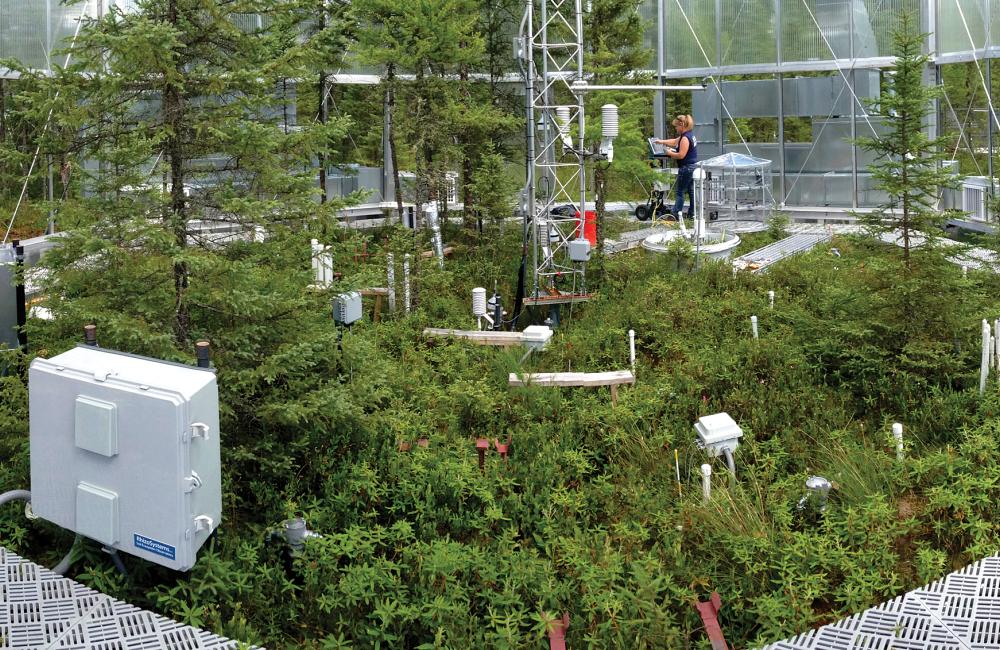Two years into a decade-long field experiment, ORNL scientists and their collaborators have found that ancient carbon buried deep inside northern peat- lands is resistant to release even as the soil warms.
ORNL is leading the Department of Energy, Office of Science, project called SPRUCE—for Spruce and Peatlands Responses under Changing Environments—to gauge the ecosystem’s sensitivity to future conditions, both plausible and extreme. Peatlands are of particular interest because they hold an estimated third of the world’s carbon despite occupying only 1.5 to 3 percent of the Earth’s surface.
Because peatlands store so much carbon, the concern is whether they will release significant amounts of carbon dioxide or methane—the latter being a more potent greenhouse gas—under changing conditions.
To undertake the study, ORNL scientists designed 10 open-top enclosures, 12 meters across and 8 meters tall, into which warmed air and elevated CO2 are injected into the atmosphere and the soil is warmed to a depth of 2 to 3 meters. The enclosures sit atop deep collars isolating the belowground water supply. The full experiments occupy a 7-acre plot in the U.S. Forest Service’s Marcell Experimental Forest in northern Minnesota.
Scientists from 30 institutions are working with ORNL to explore the peat- lands’ fundamental response to four different temperature conditions—ranging from 2.25 to 9 degrees Celsius—with and without elevated levels of atmospheric CO2. In addition, two enclosures serve as controls, with no artificial warming or added CO2. The system is designed to provide whole ecosystem warming, using both underground heat and atmospheric warming from the elevated CO2 levels.
“We built a system to study peat- lands, from the bottom of the peatland’s microbial system to the tops of trees, that gives us a glimpse of what various futures might be like as temperatures increase,” said ORNL environmental scientist Paul Hanson, the project’s coordinator.
The scientists use automated systems at half-hour intervals to measure environmental characteristics such as soil and atmospheric temperatures, light and moisture levels, wind speed and direction, and levels of CO2, methane and other gases. They use periodic measurements to study plant growth and survival, microbial community activity and composition, peat decomposition, and ecosystem biogeochemical and hydrologic functions.
“We are running the experiment 365 days a year, 24 hours a day, maintaining constant differential temperature treatments. That is unusual; other experiments having limited infrastructure might only be warmed when the sun’s up. We’re also doing it in such a way that we retain seasonal temperature patterns,” Hanson noted.
As detailed in a recent issue of Nature Communications, SPRUCE scientists found only surface peat, less than 30 centimeters deep, to be responding to elevated temperatures, while deeper reserves of ancient peat were unaffected even after being warmed by 9 degrees Celsius in the first 13 months.
The end of the 2017 growing season marks two years of whole-ecosystem warming, and the deep stores of carbon have maintained insensitivity to changing conditions so far, Hanson said.
“The experiment is giving us exactly what we wanted as a footprint for studying future conditions of this important, under- studied ecosystem,” Hanson said. “After just a few years, we are able to conclude that the ancient carbon in these peatlands is not highly sensitive to warming in the short term. That’s a big deal, because it demands that earth system models capture this new result.”
Hanson added that there is a possibility that belowground communities may adjust themselves to the new conditions and change their activity through time, so ORNL scientists will continue to sustain the manipulations and take measurements over a full decade. He also clarified that the findings are specific to the temperate SPRUCE peatland and could be different in other high-carbon ecosystems such as those occupying permafrost areas farther north.


